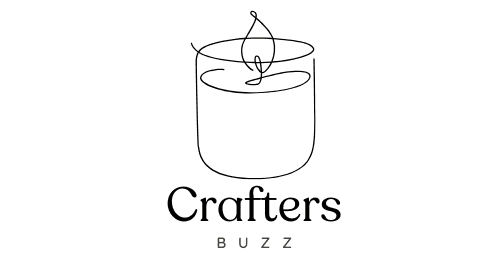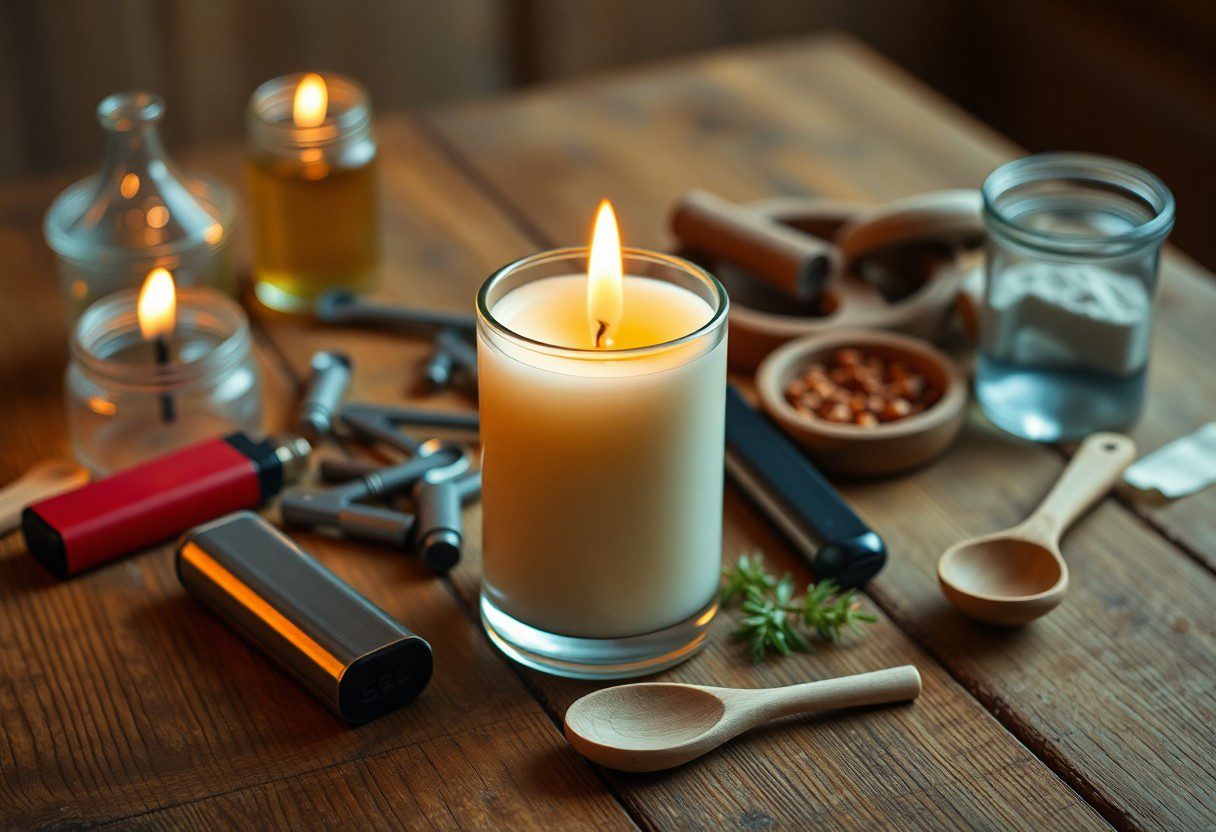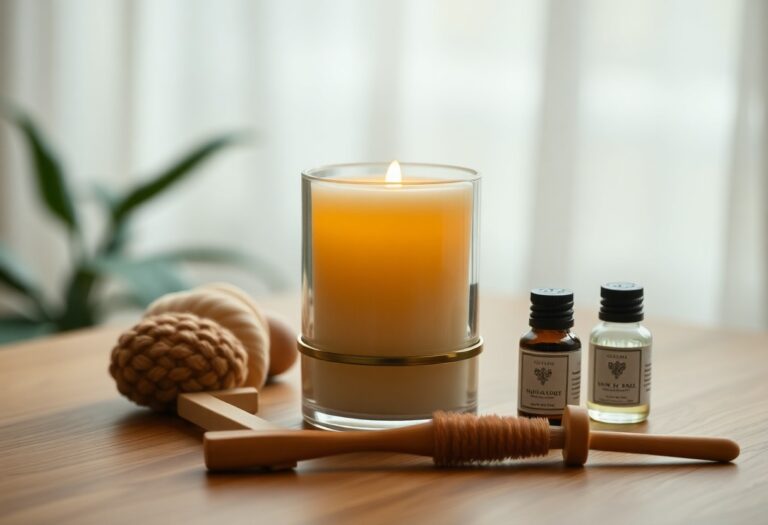Tips to avoid tunneling and uneven burning in candles.
Selecting the appropriate wick size is crucial for achieving an optimal burn in candle making. The wick serves as the conduit for fuel, drawing wax up to the flame where it is vaporized and combusted. If the wick is too small, it may not produce enough heat to melt the wax adequately, leading to a poor burn and wasted wax.
Conversely, a wick that is too large can create an excessively large flame, resulting in soot production, uneven burning, and a shortened candle life. To determine the right wick size, one must consider several factors, including the type of wax used, the diameter of the container, and the fragrance load. For instance, paraffin wax typically requires a different wick size compared to soy or beeswax.
Additionally, a container with a wider diameter will necessitate a larger wick to ensure that the entire surface of the wax melts evenly. Candle makers often refer to wick sizing charts provided by manufacturers, which take into account these variables to recommend specific wick sizes for different wax types and container dimensions.
Using the proper container size
The size of the container plays a significant role in how a candle burns. A container that is too small may lead to overheating, while one that is too large can result in an inefficient burn. The ideal container should allow for a balanced heat distribution, ensuring that the wax melts evenly and that the wick can maintain a consistent flame.
When selecting a container, it is essential to consider both its height and diameter, as these dimensions will influence how quickly the candle burns and how well it retains heat. Moreover, the material of the container also impacts the burning process. Glass containers are popular due to their ability to withstand heat and their aesthetic appeal.
However, not all glass is created equal; thicker glass can retain heat better than thinner varieties, which may crack under high temperatures. Metal containers can also be used but require careful monitoring to prevent overheating. Ultimately, choosing the right container size and material is vital for ensuring a safe and effective burn.
Using the correct wax type
The choice of wax is fundamental in candle making, as it directly affects the burn quality, scent throw, and overall performance of the candle. There are several types of wax available, each with its unique properties. Paraffin wax is one of the most commonly used due to its affordability and excellent scent throw.
However, it is derived from petroleum and may not appeal to those seeking eco-friendly options. Soy wax has gained popularity in recent years as a renewable alternative to paraffin. It burns cleaner and produces less soot, making it a preferred choice for many consumers concerned about indoor air quality.
Beeswax is another natural option known for its long burn time and subtle honey scent. Each type of wax has its melting point and burning characteristics, which must be taken into account when crafting candles. For example, soy wax typically requires a larger wick compared to paraffin due to its higher melting point.
Understanding these differences allows candle makers to select the most suitable wax for their desired outcome.
Properly trimming the wick
Wick maintenance is an often-overlooked aspect of candle care that can significantly impact performance. Trimming the wick before each use is essential for achieving a clean burn and preventing excessive soot production. A wick that is too long can create a larger flame than necessary, leading to uneven melting and potentially hazardous situations such as flickering or smoking.
Ideally, wicks should be trimmed to about 1/4 inch before lighting. In addition to promoting a cleaner burn, properly trimmed wicks help extend the life of the candle. A shorter wick allows for a more controlled flame, which in turn reduces the amount of wax consumed during each burn session.
This practice not only enhances safety but also maximizes enjoyment by allowing for longer-lasting fragrance release without overwhelming the senses with smoke or soot.
Allowing the candle to fully melt
One common mistake made by candle users is extinguishing the candle before it has had a chance to fully melt across its surface. This phenomenon is known as “tunneling,” where only a small portion of the wax around the wick melts while the rest remains solid. Tunneling not only wastes wax but also diminishes the overall fragrance experience since only part of the candle is utilized.
To avoid this issue, it is recommended that candles be burned for at least one hour for every inch in diameter of the container. For example, if you have a candle with a 3-inch diameter, allowing it to burn for at least three hours will help ensure that the entire top layer of wax melts evenly. This practice not only maximizes fragrance throw but also promotes an even burn throughout the life of the candle.
Avoiding drafts and air flow
The environment in which a candle burns can significantly affect its performance. Drafts and air currents can cause flickering flames and uneven burning patterns, leading to wasted wax and potential safety hazards. It is advisable to place candles in areas free from direct airflow, such as away from open windows, air conditioning vents, or fans.
Additionally, maintaining a stable temperature around the candle can enhance its burning efficiency. Extreme temperature fluctuations can cause the wax to contract or expand, leading to cracks or uneven surfaces that may affect how well the candle burns. By ensuring that candles are placed in stable environments with minimal airflow, users can enjoy a more consistent and enjoyable burning experience.
Rotating the candle while burning
An often-overlooked technique for optimizing candle performance is rotating the candle while it burns. This practice helps distribute heat evenly across the surface of the wax, promoting an even melt pool and reducing the likelihood of tunneling. By gently rotating the candle every so often during its burn time, users can encourage uniform melting and prolong the life of their candles.
This technique is particularly beneficial for larger candles or those with multiple wicks. In such cases, uneven heat distribution can lead to one side melting faster than another, resulting in an imbalanced burn. By rotating the candle periodically, users can mitigate this issue and ensure that all areas of the wax are utilized effectively.
Using a candle topper or lid
Candle toppers or lids serve multiple purposes that enhance both functionality and aesthetics in candle use. These accessories can help regulate airflow around the flame, minimizing drafts that could disrupt an even burn. Additionally, they can trap heat within the container, promoting a more efficient melt pool and reducing soot production.
Moreover, using a lid when not in use can protect candles from dust and debris while also preserving their fragrance potency. Many scented candles lose their aroma over time when exposed to air; therefore, covering them when not in use can help maintain their scent integrity for longer periods. Candle toppers come in various designs and materials, allowing users to choose options that complement their home decor while enhancing their overall candle experience.
In conclusion, understanding these various aspects of candle care—from choosing the right wick size to utilizing accessories like lids—can significantly enhance both safety and enjoyment during use. By paying attention to these details, users can ensure that their candles burn efficiently while providing an inviting atmosphere filled with delightful fragrances.
If you’re looking for more tips on how to avoid tunneling and uneven burning in candles, you may want to check out this article on











